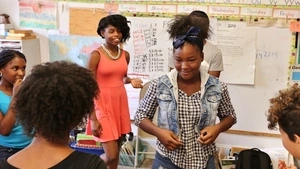For as long as there have been schools, school discipline has followed a simple formula. Student A hurts student B. Student A is punished.
But that formula is rarely satisfying, or helpful, for Student A, Student B, their classmates, or their teacher. Finding a better way — one still centered in responsibility that allows for nuance and growth — is the purpose of restorative justice.
Restorative justice has the potential to transform school cultures across the intersections of race, class, gender, ability, and sexuality to better serve ALL our communities.
For this Black Lives Matter at School Week of Action, we invited five emerging Penn GSE scholars, including former classroom teachers, to offer ideas for how you can bring restorative justice practices into your classroom.
Make sure that everyone is on board
Restorative justice is not the teacher’s response to a broken rule. It’s an everyday mindset.
Restorative justice requires cultivating and maintaining a presence of supportive, nurturing relationships within an ecosystem of trust and accountability, where all stakeholders—including teachers and administrators—must commit to making things right when they have caused harm.
Everyone is a community member, and even those who cause harm or violate community norms deserve dignity and respect. The aim is to identify why the harm took place, what needs are not being met in the community, how to shift or address those needs, and collectively agree on how to move forward.
Build community by building trusting relationships
You are not going to transform pain or harm overnight, nor can you do it alone. The aim is to build community with your students, their families or other adults in their lives, and fellow educators.
Building community begins with building authentic relationships. How much do you know about your students and how much do they know about you?
Trust takes time to build and will look different for each student. Beginning with restorative practices demonstrates to students that you are willing and open to getting to know them beyond their test scores and academic performance.
Deepen restorative justice through circles
One way to build community, and eventually deepen restorative justice practices in the classroom, is through circles: structured conversations that help students and teachers address conflicts and support one another.
Even at their most basic, circles can be a check-in to set classroom norms and reinforce communal goals. After teachers receive proper training, they can use more advanced “harm circles” as a powerful way to understand actions, take accountability, and, when possible, begin to repair harm.
The Oakland Unified School District created a great primer that shows the healing role that circles can play in the classroom.
Understand how this fits with the bigger picture
Research has consistently shown that Black and brown children (especially girls), LGBTQ+ students, students with special needs, immigrant students, and students with disabilities are likely to be disciplined more harshly than their White peers. Studies have also shown that adults often perceive students from these groups to be older or physically larger than they actually are.
These children are more likely to be suspended or expelled from school, and they are more likely to be turned over to the criminal justice system. Those punitive punishments have a lasting impact on students’ long-term physical, emotional, and mental health.
We say this because it’s important to understand that improving school discipline is part of the ongoing struggle for social justice in America, along with the prison abolition movement, and efforts to end discrimination in housing and pay.
The stakes for our kids are high. But so is the potential to improve the educational experience with more just educational choices.

About the Black Lives Matter At School Week of Action
This content is a graduate student-driven contribution in recognition of the Black Lives Matter At School Week of Action, taking place nationwide February 3–7, 2020. Black Lives Matter At School is a national coalition of educators, parents, and students organizing for racial justice in public education. The core demands envision the starting point for racial justice as (1) the dismantling of punitive, zero-tolerance discipline policies that disproportionately push out Black students; (2) the increased retention and recruiting of Black educators to serve all students; (3) the mandating of Black History & Ethnic Studies courses as K-12 graduation requirements; and (4) the funding of school counselors and nurses matched with a divestment from police officers within public schools. During the Week of Action, educators are encouraged to teach lessons on Black history, intersectional justice, and the power of youth and community activism. You can learn more at blacklivesmatteratschool.com.
By Penn GSE doctoral students Janay Garrett, Daris McInnis, Christopher R. Rogers, Laronnda Thompson, and Latricia Whitfield.
Subscribe to the Educator's Playbook
Get the latest release of the Educator's Playbook delivered straight to your inbox.
Media Inquiries
Penn GSE Communications is here to help reporters connect with the education experts they need.
